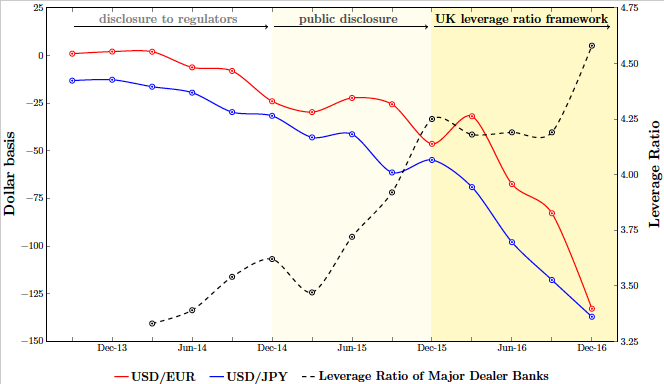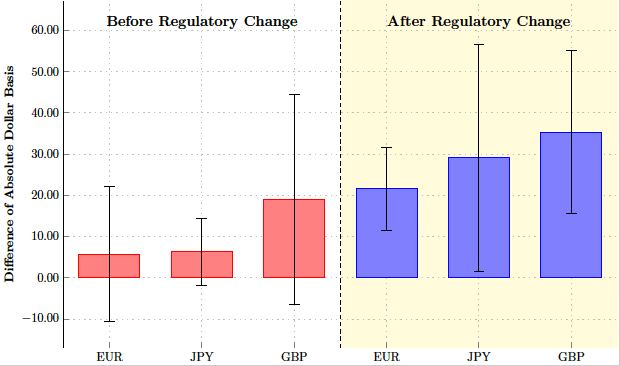Covered interest parity (CIP) is a long-standing axiom of international finance (e.g. Keynes 1923, Frankel and Levich 1975, Akram et al. 2008). It states that the absence of arbitrage opportunities implies that the difference in the rate of interest on two riskless bonds in different currencies should be equal to the difference between the forward and spot exchange rates. Equivalently, the rate of interest on a riskless dollar loan in the money market should equal the rate of borrowing (or investing) in another currency – while at the same time covering the foreign exchange (FX) exposure via an FX swap or forward contract. If not, arbitrageurs could make a seemingly riskless profit from this anomaly. Take, for example, the case in which the rate on direct dollar funding is lower than the rate on synthetic dollar funding (i.e. the dollar rate implied by CIP in the FX swap or forward market). In this instance, an arbitrageur could make a riskless profit by borrowing one dollar in the money market, swapping it into sterling at the spot rate and investing the resulting amount in the sterling money market, then selling the sterling proceeds at a predetermined price (the forward rate) in exchange for dollars.
But despite holding for decades in practice, this relationship has appeared to break down in the past few years. The interest rates on synthetic dollar funding in different currency markets, including the euro and the Japanese yen, have been persistently different from the interbank dollar rate beyond what can be explained by transaction costs. This recent development has sparked widespread interest by regulators and market participants around the world for different reasons. First, it is because of the sheer size of the market – CIP determines the pricing relationships in the FX swap and forward markets, which have an estimated notional value north of $30 trillion. Second, it is because traditionally CIP deviations have been associated with periods of market stress, especially during the Global Crisis. Third, CIP deviations imply an increase in the cost of synthetic dollar funding (or equivalently the cost of currency hedging), potentially changing the behaviour of banks and international investors in a way that could threaten financial stability – for example, by incentivising them not to hedge their FX exposures or invest in more risky assets to cover the higher costs.
Our recent research (Cenedese et al. 2019) asks whether this can be explained by the leverage ratio requirement on dealer banks. While previous research has analysed different determinants of CIP deviations (e.g. Du et al. 2018, Rime et al. 2018, Borio et al. 2018), the evidence is far from conclusive, as the current literature relies on aggregate data that prevent a neat empirical identification of the underlying determinants. Also, while the literature finds the leverage ratio to have an effect on CIP deviations, it does not quantify it. Our data also allow us to learn about the supply curve of FX swaps at the dealer level, as opposed to the aggregate level as is the case in the rest of the literature.
The role of the leverage ratio
In the wake of the Global Crisis, policymakers and regulators embarked on a bundle of financial reforms, aiming to enhance the ability of the banking sector to absorb capital losses. As part of this package, the Basel Committee on Banking Supervision (BCBS) introduced a minimum requirement on the leverage ratio, defined as the capital measure over the exposure measure, to act as a non-risk based ‘backstop’ to the risk-weighted capital requirement (BCBS 2014). While the objective of the Committee was to make the banking system safer, some commentators argue that the leverage ratio has also significantly increased the costs of financial intermediation, especially for balance sheet-intensive activities (e.g. ESRB 2016a, 2016b, Duffie 2018). This happens because the leverage ratio is concerned with the size rather than the composition of a bank's balance sheet relative to its capital.
As an illustrative example, Figure 1 displays the average leverage ratio of major dealer banks operating in London (the global hub for FX trading) and the one-month dollar basis (the difference between the dollar lending rate in the US money market and those implied by the FX market) on the euro and yen against the dollar. While this chart provides evidence of a strong correlation – the basis widened substantially between 2014 and 2016, reaching more than 100 basis points per annum, while dealers faced tighter leverage constraints – testing any causal relationship between the leverage ratio and the dollar basis remains difficult, as both components may be driven by common yet unobserved factors. The most important challenge for the empirical identification is to find an exogenous variation in the leverage ratio requirement of dealer banks. Also, the leverage ratio requirement varies little over time and whenever it is revised, it may change for all major banks at the same time and be correlated with unobserved bank characteristics. Finally, to quantify the effects of the leverage ratio requirements on the dollar basis, we should disentangle the changes in supply from those affecting demand.
Figure 1 Dollar basis and leverage ratio
We fill these gaps in the literature using supervisory data on dealer banks, matched with contract-level data on forward exchange rates enriched with counterparty information – a critical ingredient in isolating factors that affect the supply side from those that affect the demand side. We also differentiate the impact of the leverage ratio rule from one of the risk-weighted capital ratio requirements.
Findings and policy implications
We address these challenges by running panel regressions with counterparty currency-time fixed effects that account for all time-varying counterparty and currency-specific characteristics (in the spirit of Khwaja and Mian 2008). We find that dealer banks charge an extra premium to their clients for synthetic dollar funding (or equivalently dollar hedging) when the leverage ratio increases. Intuitively, the leverage ratio makes it costly for banks to engage in low-margin activities that require high turnover to be profitable, and the intermediation of FX swaps and forwards effectively expands a bank’s balance sheet. This expansion occurs as dealer banks are unable to net positions across different counterparties for the calculation of their regulatory leverage exposure.
We then estimate that a one standard deviation increase in the leverage ratio of dealer banks can raise the dollar funding cost for clients by up to 28 basis points per annum. This translates, using a simple back-of-the-envelope calculation, into (up to) $92 billion of extra borrowing costs per year, given an outstanding amount of dollar-denominated FX swaps and forwards of $33 trillion at the end of December 2016.
We then improve our identification by exploiting plausibly exogenous variations in banks' capital resulting from either the introduction of the UK leverage ratio framework in January 2016 or the public disclosure of the leverage ratio in January 2015. In doing so we account for potential omitted variables that could correlate with banks' balance sheet shocks.
We visualise the impact of the introduction of the UK leverage ratio framework on the dollar basis in Figure 2. Here we report the difference in absolute dollar basis in basis points per annum between the treatment groups (major UK banks with deposits over £50 billion) and control groups (other banks) before and after the change in regulatory requirements in January 2016. In our sample, four dealer banks form our treatment group and the subsidiaries of seven international banks act as a control group. We also add to each bar the 95% confidence interval. While the differences in absolute dollar basis were statistically insignificant during the pre-intervention period, they turn out to be statistically significant in the post-intervention period.
Figure 2 Regulatory change and dollar basis
In conclusion, we provide evidence that the additional funding cost faced by international investors to borrow dollars through the foreign exchange market is directly linked to the leverage ratio rule of dealer banks. Overall, our findings help shed light on the potential costs of the leverage ratio framework while leaving any assessment of the net welfare effect of the leverage ratio rule for future research. In addition, further research could also try to answer the open question of whether market participants will adapt to the new regulation.
References
Akram, F, D Rime, and L Sarno (2008), “Arbitrage in the Foreign Exchange Market: Turning on the Microscope”, Journal of International Economics, 76, 237–253.
BCBS (2014), “Basel III Leverage Ratio Framework and Disclosure Requirements”, Bank for International Settlements.
Borio, C, M Iqbal, R McCauley, P McGuire, and V Sushko (2018), “The Failure of Covered Interest Parity: FX Hedging Demand and Costly Balance Sheets”, Working Paper, Bank for International Settlements.
Cenedese, G, P Della Corte, and T Wang (2019), “Currency Mispricing and Dealer Balance Sheets”, Bank of England Staff Working Paper no. 779.
Du, W, A Tepper, and A Verdelhan (2018), “Deviations from Covered Interest Rate Parity”, Journal of Finance, 73, 915–957.
Duffie, D (2018), “Financial Regulatory Reform After the Crisis: An Assessment”, Management Science, 64, 4471–4965.
ESRB (2016a), “Market Liquidity and Market-Making”, European Systemic Risk Board.
ESRB (2016b), “Preliminary Investigation into the Potential Impact of a Leverage Ratio Requirement on Market Liquidity”, European Systemic Risk Board.
Frenkel, J A, and R M Levich (1975), “Covered Interest Arbitrage: Unexploited Profits?”, Journal of Political Economy, 83, 325–338.
He, Z, and A Krishnamurthy (2018), “Intermediary Asset Pricing and the Financial Crisis”, Annual Review of Financial Economics, 10, 173–197.
Keynes, J M (1923), A Tract on Monetary Reform, Macmillan.







